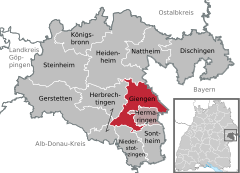Giengen
| Giengen | ||
|---|---|---|

Giengen from the Bruckersberg
|
||
|
||
| Coordinates: 48°37′18″N 10°14′42″E / 48.62167°N 10.24500°ECoordinates: 48°37′18″N 10°14′42″E / 48.62167°N 10.24500°E | ||
| Country | Germany | |
| State | Baden-Württemberg | |
| Admin. region | Stuttgart | |
| District | Heidenheim | |
| Government | ||
| • Mayor | Gerrit Elser (Ind.) | |
| Area | ||
| • Total | 44.05 km2 (17.01 sq mi) | |
| Population (2015-12-31) | ||
| • Total | 19,342 | |
| • Density | 440/km2 (1,100/sq mi) | |
| Time zone | CET/CEST (UTC+1/+2) | |
| Postal codes | 89537 | |
| Dialling codes | 07322 | |
| Vehicle registration | HDH | |
| Website | www.giengen.de | |
Giengen (full name: Giengen an der Brenz) is a former Free Imperial City in eastern Baden-Württemberg near the border with Bavaria in southern Germany. The town is located in the district of Heidenheim at the eastern edge of the Swabian Alb, about 30 kilometers northeast of Ulm on the Brenz River.
Giengen is today a dynamic community and home to several well-known companies, such as Margarete Steiff GmbH, creator of the teddy bear, and Albert Ziegler GmbH, a European leader in fire department equipment.
Positioned on the Nuremberg-Ulm-Constance route, one of the main feeder routes of the Compostella Trail, Giengen is visited each year by an increasing number of walking pilgrims on their way to Santiago de Compostella.
The first documentary evidence of the town was contained in a chronicle of the monastery of Peterhausen that reported on the death in battle in 1078 of margrave Diepold II von Vohburg, lord of Giengen. In 1147, Adele, daughter of Diepold III, was married to Emperor Frederick I Barbarosa but was divorced after a few years due to childlessness. Barbarosa was an occasional visitor and resident and it was probably during his stay in 1171 that he granted market rights and the unicorn coat of arms to the town. Still referred to as a villa (village) in a document dated 1216, Giengen had seemingly attained city (civitas) status by 1252.
The city was pawned more than once by successive emperors, and the counts of Württemberg and of Öettingen both vied for control over city. It was only in 1395 that Giengen’s status as a Free Imperial City, independent of any lord but the Emperor, was finally acknowledged by all. In 1481, the city was exempted from the jurisdiction of any outside court. Giegen, which has been a member of leagues of Swabian Free cities since the late 14th Century, joined the powerful Swabian League when it was set up in 1488. The city took part in the League’s successful war against Württemberg in 1519.
According to the celebrated Reichsmatrikel of 1521 - the document that laid down the military and monetary obligations for each of the Imperial Estates – Giengen was obligated to contribute 2 horsemen, 13 foot soldiers and 60 gulden. That contribution ranked near the bottom on the list of the 85 Free Imperial Cities then in existence, reflecting the small size and modest resources of the city (by comparison, the contribution of nearby Ulm was set at 29, 120 and 600 respectively). Yet, Giengen was to be one of the 50 Free Imperial Cities that were to survive the Thirty Years’ War and the Peace of Westphalia and continue as quasi-sovereign entities until 1802-03.
...
Wikipedia




